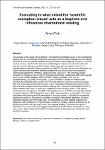Evaluating to what extent the ‘scientific exemption clause’ acts as a loophole and influences international whaling
| dc.contributor.author | Wick, A. | |
| dc.date.accessioned | 2023-12-22T16:09:45Z | |
| dc.date.available | 2023-12-22T16:09:45Z | |
| dc.date.issued | 2023 | |
| dc.identifier.citation |
Wick, A. (2023) 'Evaluating to what extent the ‘scientific exemption clause’ acts as a loophole and influences international whaling', The Plymouth Student Scientist, 16(2), pp. 110-131. | en_US |
| dc.identifier.uri | https://pearl.plymouth.ac.uk/handle/10026.1/21844 | |
| dc.description.abstract |
The purpose of the study was to identify if the scientific exemption clause of the international whaling ban is a loophole for commercial hunting to continue under disguise and to evaluate the level of public perception towards whaling exemptions and longevity of policy. The study used secondary data from the International Whaling Commission to calculate total catch data for commercial and scientific brackets. It also used primary data in the form of questionnaires to identify public knowledge and belief. From the results, it was identified that Japan had the most consistent scientific programme and Norway the most consistent commercial programme. With this, Japan recorded a peak of 1,188 individual whales compared to Norway’s peak of 376 for commercial practises. Iceland was difficult to evaluate due to a loss of data between 1990 and 2002, meaning catches could not be representatively calculated or compared. Japan’s scientific catches for minke whales consistently exceeded catch quotas, whilst Norway failed to reach its commercial quotas. 62% of the 58 respondents had not heard of the International Whaling Commission (IWC), with 60% also unaware of the international whaling ban. This lack of knowledge led 59% to believe that the IWC was, in some way, ineffective in informing the public. Split opinion existed towards exemptions, with 40% believing they should and 40% believing they should not exist. However, 42% believe that they would have longevity in conservation. The main conclusion was that the scientific exemption is, to some extent, a loophole for commercial practises to continue. This means countries can exploit international legislation and hunt vulnerable species, all within legal right. The comparison to peak catches supports this statement, with a difference of 452 in favour of science. Norway used the exemption as an additional practise, with primary focus on commercial whaling. The public are split on exemptions, but narrow margins suggest a belief that they will work in the long term. This may, in turn, alter viewpoints towards whaling practises as education and awareness from the IWC increases. | en_US |
| dc.language.iso | en | en_US |
| dc.publisher | University of Plymouth | en_US |
| dc.rights | Attribution 3.0 United States | * |
| dc.rights.uri | http://creativecommons.org/licenses/by/3.0/us/ | * |
| dc.subject | International Whaling Commission | en_US |
| dc.subject | Whaling | en_US |
| dc.subject | moratorium | en_US |
| dc.subject | scientific whaling | en_US |
| dc.subject | Japan | en_US |
| dc.subject | Norway | en_US |
| dc.subject | Iceland | en_US |
| dc.subject | questionnaire | en_US |
| dc.title | Evaluating to what extent the ‘scientific exemption clause’ acts as a loophole and influences international whaling | en_US |
| dc.type | Article | en_US |
| plymouth.issue | 2 | |
| plymouth.volume | 16 | |
| plymouth.journal | The Plymouth Student Scientist |




